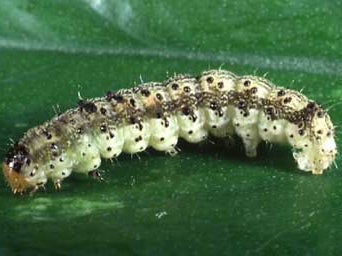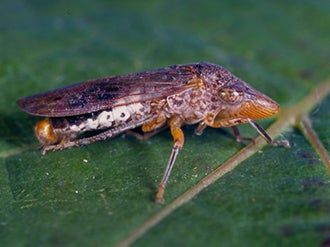
Pink Bollworm
Pectinophora gossypiella
The pink bollworm, Pectinophora gossypiella, became a major pest of cotton in southern California in 1965. Since 1968 it has been the target of a Sterile Insect Technique (SIT) program aimed at preventing the spread of pink bollworm into the Central Valley of California. The SIT involves a modern mass-rearing facility in Phoenix Arizona that was built by the California Cotton industry and is operated by the APHIS branch of the United States Department of Agriculture (USDA) in cooperation with the California Department of Food and Agriculture (CDFA).
Robert T. Staten, Center Director of the USDA lab in Phoenix, suggested a pilot project several years ago aimed at updating the SIT by replacing the radiation sterility method with a conditional lethal gene approach using insect transgenesis methods, yet to be discovered. He asked the Miller lab at UC Riverside to work out the details. Steve Thibault provided the key breakthrough in his dissertation research culminating in February of 1998 with genetic transformation of pink bollworm using a piggyBac transposable element from Malcolm Fraser at Notre Dame.
The first transgenic pink bollworm had the enhanced green fluorescent protein inserted (egfp) as a marker gene. This strain, called the EGFP strain was sent to the Staten lab in Phoenix under a permit from USDA-APHIS. Ernie Miller spent the next several years working with the EGFP strain in quarantine at the Staten labs.
He showed that outcrossing EGFP with the lab strain (APHIS), then backcrossing to homozygosity generated a new strain that was more fit as measured by percent male pheromone trap catch compared to APHIS males. This increased fitness by outcrossing was predicted by population geneticists.
It took another five years to perfect the conditional lethal system, which was finally achieved in the summer of 2002 using a plasmid constructed by Dr. Luke Alphey of Oxford University, Oxford, UK. The transgenic pink bollworm strain was moved from UC Riverside to USDA-APHIS in Phoenix on January 24, 2003 into quarantine to be back-crossed for greater viability and to await a permit for field release, which is expected to take some time. Indeed, as of this writing, there has been no approval of a permit request to do field testing with released transgenic pink bollworm, neither marked strain nor conditional lethal strain.

Tobacco Budworm
Heliothis virescens
The tobacco budworm,Heliothis virescens, has been a target insect for agrochemical industry for many years. With the advent of insect-resistant transgenic cotton plants, the market for insecticide control of Heliothis complex decreased dramatically, but this pest insect still commands attention. We are using it as a test insect to insert genes. Our initial results showed that the transposable element piggyBac is present in our commercial strain in an active form that is indistinguishable from the one obtained originally from the cabbage looper, Trichoplusia ni. In partnership with Yoon-Seong Park at Kansas State University, it now appears that Heliothis contains a unique piggyBac-like element that is intact and functional. This explains why we were never able to obtain stable transformed strains using the piggyBac element from T. ni.
The tobacco budworm,Heliothis virescens, has been a target insect for agrochemical industry for many years. With the advent of insect-resistant transgenic cotton plants, the market for insecticide control of Heliothis complex decreased dramatically, but this pest insect still commands attention. We are using it as a test insect to insert genes. Our initial results showed that the transposable element piggyBac is present in our commercial strain in an active form that is indistinguishable from the one obtained originally from the cabbage looper, Trichoplusia ni. In partnership with Yoon-Seong Park at Kansas State University, it now appears that Heliothis contains a unique piggyBac-like element that is intact and functional. This explains why we were never able to obtain stable transformed strains using the piggyBac element from T. ni.

Glassy-winged sharpshooter and Pierce's disease
Dr. Miller’s laboratory focuses partly on genetic transformation of insects for practical ends. Past project included pink bollworm and tobacco budworm. Current projects include symbiotic control of Pierce's disease in grapevine and fungal control of crop pests.
Pierce’s disease (PD) reached epidemic proportions in the early 1990s in Southern California. Although the pathogenic bacterium, Xylella fastidiosa (PD-XF) has been present in wild host for many years, the disease was spread only ineffectively by local leafhopper insects. Upon the arrival of the glassy-winged sharpshooter (GWSS),Homalodisca vitripennis, for from its native ranges in Florida and the southeast and northeastern Mexico, this picture changed drastically. Hardest hit initially was the small wine-growing area of Temecula, south of Riverside. The initial losses of grapevines to Pierce’s disease lead to a community effort initiated in the Temecula area that created research support that got underway by 1999.
GWSS is larger, has a wider host range and is much more active in terms of dispersal than native sharpshooter insects. Even though GWSS is not as efficient at transmission of PD-XF, the much greater propensity to visit vineyards and the unusual habit of GWSS of feeding from even the oldest part of the trunk of the grapevine plant makes it unique amongst sharpshooters and also drastically increases the probability of infection of grapevines by PD-XF. Even before GWSS and PD appeared in Temecula, CA starting around 1998-1999, GWSS had accumulated other strains of XF that caused other very specific diseases in the infested areas of southern California. Notable among these were oleander leaf scorch and plum diseases, both of which have caused widespread losses of these landscape ornamentals.
Our initial seed funding from CDFA lead to proof of feasibility of the paratransgenesis approach when Carol Lauzon identified an endophytic bacterium in GWSS, which could be used to deliver anti-Pierce’s products to control the pathogenic bacterium and appeared to be occupying the same space in both the host plants and vector insect, suggesting that endophyte products would reach the pathogen.
Proof of feasibility lead to a larger project that included Carol, David Lampe, Don Cooksey at UCR in Plant Pathology Department and Blake Bextine joined as a postdoctoral. This team laid the ground work for the first summer of field trials with the transgenic endophytic bacterium held in 2003. After two seasons (Summer 2003 through Summer of 2004) of field trials of the marked transgenic Alcaligenes, progress was hampered by regulatory strangulation; EPA required grapevines to be burned at the end of each test.
Blake Bextine left the project for a faculty position at the University of Texas, Tyler,Don Cooksey, DaveLampeand Carol Lauzon went on to other projects and Angray Kang working first at Westminister University in London and now Queen Mary College, London, finally developed antibody reagents for use attacking the pathogenic bacterium.
